Environmental Encyclopedia
Подождите немного. Документ загружается.


Environmental Encyclopedia 3
Office of Surface Mining
active Waste Management
(OCRWM). OCRWM man-
ages federal programs for recommending, constructing, and
operating repositories for the disposal of high-level radioac-
tive wastes and spent nuclear fuel. It is also responsible for
arranging for the interim storage of spent nuclear fuel and
for research, development, and demonstration of techniques
for the disposal of
high-level radioactive waste
and spent
nuclear fuel.
In addition, OCRWM oversees the Nuclear Waste
Fund, also established by the 1982 act. The fund was estab-
lished to enable the federal government to recover all costs
of developing a disposal system and of disposing of high-
level waste and spent nuclear fuel. It is paid for by companies
that produce
nuclear power
, power consumers, and those
involved in the use of nuclear materials for defense purposes.
OCRWM has published a number of short pamphlets
dealing with the problem of waste disposal. They cover topics
such as “Nuclear Waste Disposal,” “What Will a Nuclear
Waste Repository Look Like?” “What Is Spent Nuclear
Fuel?” “Can Nuclear Waste Be Transported Safely?” and
“How Much High-Level Nuclear Waste Is There?”
OCRWM experienced a number of setbacks in the
first decade of its existence. No state was willing to allow
the construction of a high-level nuclear waste repository
within its borders. The technology for immobilizing wastes
seemed still too primitive to guarantee that wastes would
not escape in to the
environment
.
Eventually, however, OCRWM announced that it had
chosen a site under
Yucca Mountain
in southeastern Ne-
vada. The site lies on the boundaries of the
Nevada Test
Site
and Nellis Air Force Base. It is near the town of Beatty,
100 mi (161 km) northwest of Las Vegas. The site has been
studied since 1977 and should be ready to receive wastes
early sometime around 2010. Some residents of Nevada are
unhappy with the choice of Yucca Mountain as a nuclear
waste repository, however, and continue to fight OCRWM’s
decision.
[David E. Newton]
R
ESOURCES
O
RGANIZATIONS
Office of Civilian Radioactive Waste Management, Toll Free: (800) 225-
6972, Email: mowebmaster@rw.doe.gov, <http://www.rw.doe.gov>
Office of Energy Research
see
U.S. Department of Energy
1017
Office of Management and Budget
The Office of Management and Budget (OMB), established
in 1939 within the office of the President, determines both
how much money will be spent by the federal government
and what kinds of regulations will be adopted to implement
all environmental and other legislated programs.
According to the 1946 Administrative Procedures Act,
regulations “interpret, implement or prescribe law or policy.”
Draft regulations must be publicized, and agencies must
incorporate public comments into the final regulations. Ex-
ecutive Orders 12291 and 12498, issued in 1981 and 1984,
respectively, gave the Office of Information and Regulatory
Affairs (OIRA), a division of OMB, the authority to review
and approve all regulations and paperwork drafted by the
Environmental Protection Agency
, as well as all other fed-
eral agencies.
R
ESOURCES
O
RGANIZATIONS
Office of Management and Budget, 725 17th Street, NW, Washington,
D.C. USA 20503 (202) 395-3080, <http://www.whitehouse.gov/omb>
Office of Oceanic and Atmospheric
Research
see
National Oceanic and Atmospheric
Administration (NOAA)
Office of Surface Mining
In 1977 the Office of Surface Mining(OSM) was created
to police
coal
extraction within the United States and to
enforce the federal
Surface Mining Control and Reclama-
tion Act
(SMRCA). Under the auspices of OSM, citizens
are empowered to enforce
reclamation
of surface mines, as
well as deep mines, that have damaged surface features.
The government, industry, or a combination of both
is required to pay all expenses, including legal fees, when
citizens bring successful administrative or judicial complaints
for noncompliance under the SMRCA. The reclamation of
abandoned mines is funded by a tax on coal. To fund the
reclamation of new mines OSC requires performance bonds
that must cover the cost of reclamation should the operator
not complete the process.
The majority of mining states have been granted “pri-
macy” by OSM, which means that the individual states are
authorized to handle reclamation enforcement, with OSM
stepping in only when states fail to enforce the SMRCA.
There are almost 30,000 known violations that remain un-
corrected, yet OSM issues less than 25 citations a year. The

Environmental Encyclopedia 3
Off-road vehicles
majority of citations issued are disposed of by vacating the
citation or by making arrangements with the company.
There are 24,000 operations including surface mines,
deep mines, refuse piles and prep plants that come under
the act, (including those that went into operation after 1977);
about 17,000 of these have been reclaimed. Many of these
reclaimed sites are merely grass planted over
desert
, incapa-
ble of supporting any form of
wildlife
. The reclamation
plans developed for many
surface mining
sites designate
the post mining
land use
to be pastureland, but due to the
remoteness and inaccessibility, many reclaimed sites sit idle
devoid of all wildlife.
Environmentalists and other opponents of the mining
industry charge that coal industries and OSM personnel are
the same group. It is interesting to note that Harry Snyder,
the current director of OSM, was a former lobbyist for CSX
railroad and is a heavy investor in coal. According to many
critics the coal industry has become adept at manipulating
the OSM and SMCRA for its own purposes. The OSM
is currently trying to push through legislation that would
eliminate the SMRCA’s attorney fee provisions. The agency
is also in the process of throwing out numerous other
SMCRA regulations that are burdensome to the coal indus-
try, including one that bans deep mining from national parks
and wildlife refuges.
[Debra Glidden]
R
ESOURCES
P
ERIODICALS
Brown, F. “The Miner’s Watchdog Doesn’t Bite.” Sierra 34 (September/
October 1986): 28–31.
“Coal Mining: Profit Reclamation.” The Economist 319 (April 1991):
A24–26.
Sherwood, T. “Strip Search". Common Cause Magazine 15 (May/June 1989):
8–10.
O
RGANIZATIONS
Office of Surface Mining, 1951 Constitution Ave. NW, Washington, D.C.
USA 20240 (202) 208-2719, Email: getinfo@osmre.gov, <http://
www.osmre.gov>.
Office of Surface Mining, Reclamation
and Enforcement
see
Office of Surface Mining
Off-road vehicles
Off-road vehicles (ORVs) include motorcycles, dirt bikes,
snowmobiles, bicycles, and all-terrain vehicles (ATVs) that
can be ridden or driven in areas where there are no paved
roads. While the use of off-road vehicles has gained in
1018
popularity, conservationists and landowners have prompted
some legislatures to restrict their use because of the damage
the vehicles do to the
environment
.
During eight years under President Bill Clinton
(1946–), environmentalists continued their progress in lim-
iting or banning the use of off-road vehicles in federally
protected areas, such as national parks and forests. However,
with the election of George W. Bush (1946–) in 2000,
environmentalists began to worry their progress might be in
jeopardy. As of 2002, the Bush administration had sent
mixed signs regarding off-road vehicle use on
public land
.
In October 2001, the U.S.
Environmental Protection
Agency
(EPA) announced plans to impose
pollution con-
trol
restrictions on off-road vehicle engines. The EPA said
off-road vehicles, including snowmobiles, account for 13
percent of hydrocarbon
emission
released into the
atmo-
sphere
each year. The EPA wants off-road vehicle manufac-
turers to switch from two-cycle to four-cycle engines starting
in 2006. Snowmobiles would be required to reduce emissions
by 30% in 2006 and 50% in 2010. The Clinton administra-
tion had planned to phase-out snowmobiles altogether in
Yellowstone National Park
.
In 2002, the federal
Bureau of Land Management
(BLM) proposed lifting the ban on off-road vehicles in
the 50,000-acre Imperial Sand
Dunes Recreation
Area in
California. However, that same year, the BLM closed nearly
18,000 acres of federal land in the California’s Mojave
De-
sert
to off-road vehicles. The closing was necessary to protect
the
desert tortoise
, a threatened
species
.
A popular sport in desert areas, mountain passes, and
riverbeds, owners and drivers of off-road vehicles defend
their right to ride wherever they like. They contend that
the Clinton administration policy of closing federal land to
ORVs was discriminatory, since it favored recreational use
of public land only for certain groups of the public, such
as hikers, campers, and backpackers. But environmentalists
claim that the vehicles scar the land, kill
wildlife
, destroy
vegetation, and cause noise, safety and
pollution
problems.
The knobby tires of mountain bicycles contribute to
erosion
in delicate desert areas and along the sides of steep mountain
trails. Motorized off-road vehicles are more devastating to
local
ecology
as landowners across the country are finding.
In Missouri’s Black River, off-roaders typically discard
beer cans, used baby diapers, and empty motor-oil cans.
Usually clear, the Black River in places runs as green as a
sewage ditch when algae are stirred up by the commotion
of off-road vehicles. Some drivers drain their crankcases into
the river. Inevitably, the oil and gas from motorized vehicles
seeps into the river
ecosystem
. A bill passed by the Missouri
legislature in April 1988 restricted the vehicles to areas of
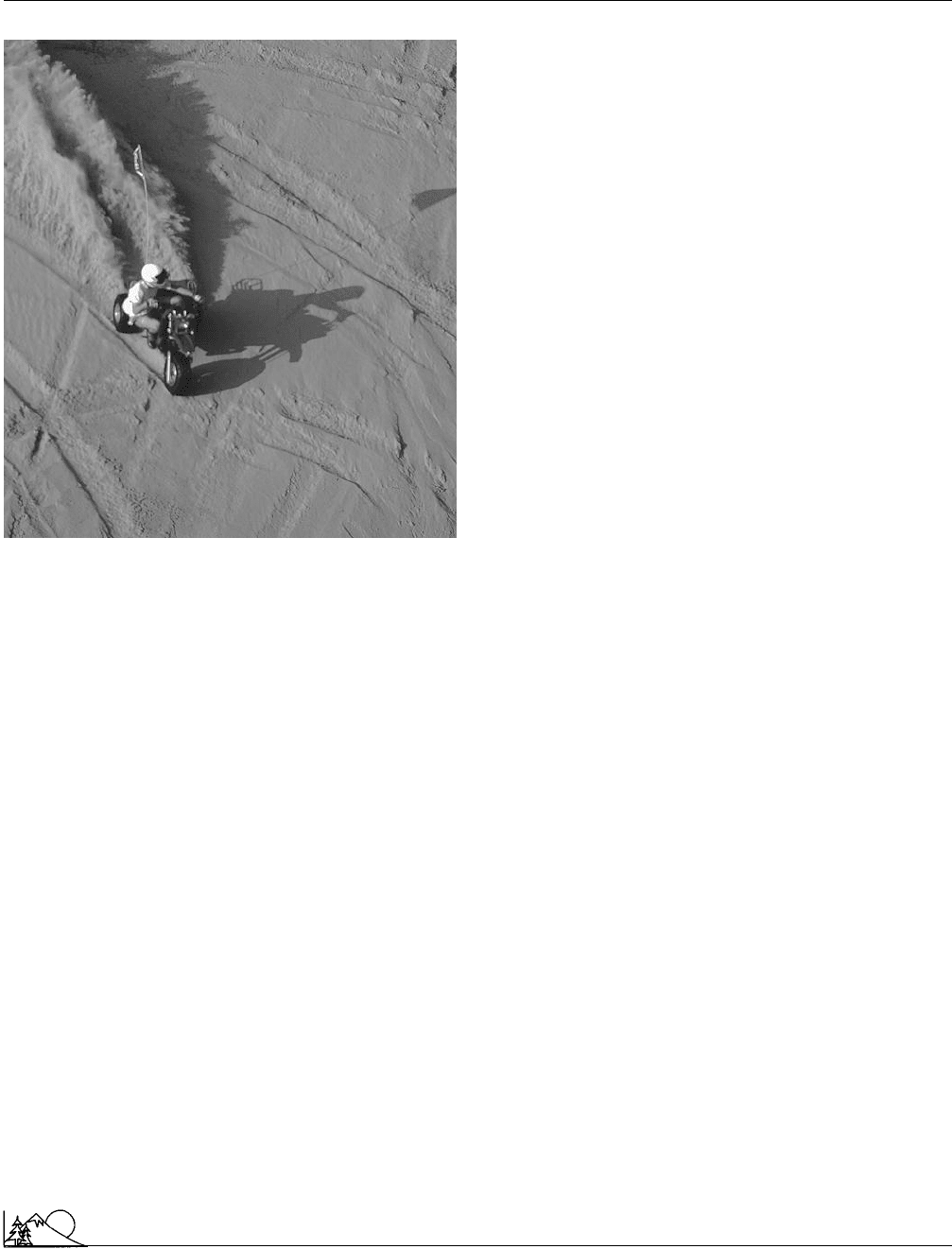
Environmental Encyclopedia 3
Ogallala Aquifer
A rider maneuvers his Honda three-wheeler
over sand dunes. (Photograph by Inga Spence. Tom
Stack & Associates. Reproduced by permission.)
the river where landowners gave permission. Since much of
the area is not posted, however, the law failed to halt a good
deal of the use of off-road vehicles in the river.
At the Chincoteague
Wildlife Refuge
in Virginia, an
environmental assessment of the effects of off-road vehicles
and foot traffic found the effects devastating to some species,
particularly the threatened piping plover. The assessment
recommended that the area be closed to the vehicles and to
all recreation during the nesting season, concluding that the
nesting site is subject to damage not only from off-road
vehicles, but also from the human intrusion accompanying
the use of these vehicles.
In California, about 500,000 acres of public land are
open to use by off-road vehicles, and California conserva-
tionists have fought since the late 1980s to ban the sport in
state parks. Off-roaders, however, waged their own battle.
Editorials in magazines for off-road vehicles users urged
readers to ignore posted property, sue for the right to use
the land, and lobby their state and federal elected officials.
More than 30 states now have enacted legislation that
regulates the sale and use of off-road vehicles, especially
motorized ones. The legislation was more a reaction to the
safety problems inherent in three-wheel vehicles than to the
detrimental ecological effects of the vehicles in pristine areas.
1019
The Consumer Product Safety Commission listed almost
1,000 deaths related to the use of ATVs from 1982 to 1988,
and hundreds of product liability suits have been brought
against manufacturers.
[Ken R. Wells]
R
ESOURCES
P
ERIODICALS
Daerr, Elizabeth. “Park Victories Losing Ground.” National Parks (July–
August 2001): 18.
“Environmentalists Decry Bush Administration’s Off–Road Vehicle Pol-
icy.” Knight–Ridder/Tribune Business News, June 25, 2001.
Kilian, Michael. “EPA to Limit Pollution From Engines in Boats, Snowmo-
biles.” Knight–Ridder/Tribune news Service, October 19, 2001.
O
RGANIZATIONS
The Wilderness Society, 1615 M St. NW, Washington, DC USA 20036,
800–843–9453, Email: member@tws.org, http://www.wilderness.org/
standbylands/orv
Offshore drilling
see
Oil drilling
Ogallala Aquifer
The Ogallala
Aquifer
is an extensive underground
reservoir
that supplies water to most of the irrigated agriculture in
the central United States. Discovered early in the nineteenth
century, this aquifer—also known as the High Plains re-
gional aquifer—became a major economic resource in the
1960s and 1970s when advanced pumping technology made
large-scale
irrigation
possible. In 1980 this aquifer sup-
ported 170,000
wells
and provided one third of all irrigation
water pumped in the United States. In the last several de-
cades, Ogallala-irrigated agriculture has redefined the land-
scape of the central United States by fostering economic
expansion,
population growth
, and the development of
large-scale agribusiness in an
arid
region.
The High Plains regional aquifer underlies eight states,
including most of Nebraska and portions of South Dakota,
Wyoming, Colorado, Kansas, Oklahoma, Texas, and New
Mexico. Covering an area of 175,000 square miles (453,250
sq km), the aquifer runs 800 miles (1,288 km) from north
to south, and stretches 200 miles (322 km) at its widest
point. Nebraska holds by far the greatest amount of water,
with 400–1,200 feet (130–400 m) of saturated thickness,
while much of the aquifer’s southern extent averages less than
100 feet (30 m) thick. Geologically, this aquifer comprises a
number of porous, unconsolidated sand,
silt
, and clay forma-
tions that were deposited by wind and water from the Rocky
Mountains. The most important of these formations is the
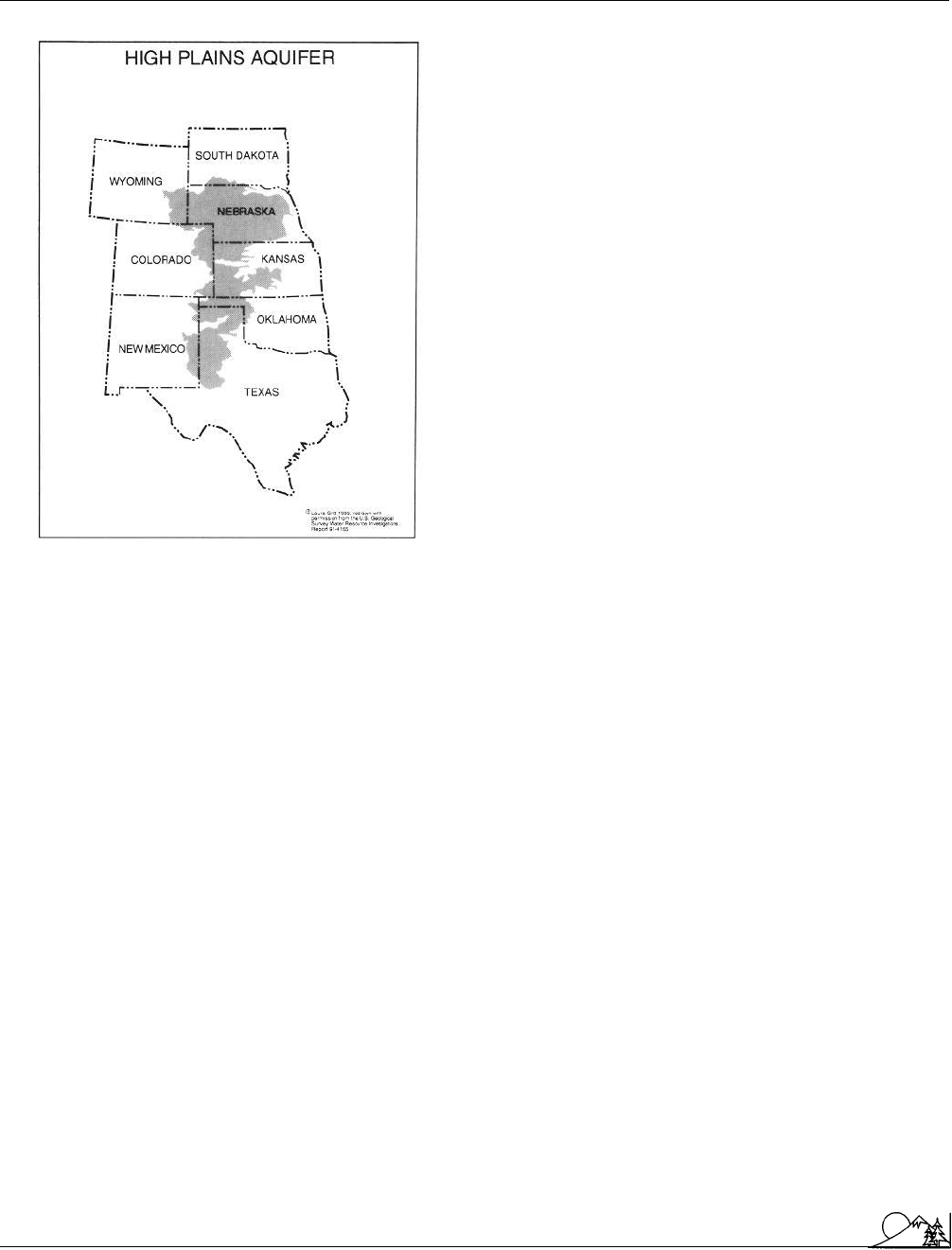
Environmental Encyclopedia 3
Oil drilling
The Ogallala, or High Plains, Aquifer. (Line draw-
ing by Laura Gritt Lawson. U. S. Geological Survey Water
Resource Investigations Report.)
Ogallala formation, which makes up seventy-seven percent
of the regional aquifer. The aquifer’s total drainable water
is about 3.25 billion acre feet.
Large volume use of
groundwater
became possible
with the invention of powerful pumps and center-pivot irri-
gation in the late 1950s. The center pivot sprays water from
a rotating arm long enough to water a quarter section (160-
acre) field. This irrigation technique is responsible for the
characteristic circular pattern visible from the air in most
agricultural landscapes in the western United States. Al-
though installation is extremely expensive, center pivots and
powerful pumps enable farmers to produce great amounts
of corn, wheat, sorghum, and cotton where low rainfall had
once made most agriculture impossible.
High-volume pumping has also reduced the amount
of available groundwater. Most water in the High Plains
aquifer is “fossil water,” which has been stored underground
for thousands or millions of years. New water enters the
aquifer extremely slowly. In most of the Ogallala region,
pumping exceeds recharge rates, a process known as water
mining, and the net volume is steadily decreasing. Region-
wide, less than 0.5% of the water pumped each year is
replaced by
infiltration
of rainwater. At current rates of
1020
pumping, the resource should be 80% depleted by about
2020.
As saturation levels in the aquifer fall, consequences
on the surface are clearly visible. Many streams and rivers,
dependent on groundwater for base flow, run dry. The state
of Kansas alone has lost more than 700 miles (1,126 km)
of rivers that once flowed year round. Center pivot irrigation,
requiring a well that can pump 750 gallons (2,839 liters) per
minute, is beginning to disappear in Texas and New Mexico,
where the aquifer can no longer provide this volume.
Groundwater pollution
is becoming more concentrated as
more
agricultural chemicals
seep into a shrinking reservoir
of Ogallala water. Many high plains towns, formerly rich
with pure, clean groundwater, now have tap water that is
considered unhealthy for children and pregnant women. As
the Ogallala runs dry, the region’s demographics are also
changing. Many farmers assumed heavy debt burdens in the
1970s when they installed center pivots. Drying wells and
falling production have led to farm foreclosures and the
depopulation of small, rural towns. Regional populations
that swelled with irrigated agriculture are beginning to shrink
again. Land ownership, formerly held by independent fami-
lies and ranchers, is increasingly in the hands of banks,
insurance companies, and corporations, which provide little
support to local communities.
[Mary Ann Cunningham Ph.D.]
R
ESOURCES
P
ERIODICALS
Aucoin, J. Water in Nebraska—Use, Politics, Policies. Lincoln: University of
Nebraska Press, 1984.
Kromm, D. E., and S. E. White. Groundwater Exploitation in the High
Plains. Lawrence: University Press of Kansas, 1992.
Oil
see
Petroleum
Oil drilling
Petroleum
occurs naturally in the earth in porous rock,
found anywhere from thousands of meters underground all
the way to the earth’s surface. The porous layer of rock
normally lies between two nonporous layers, so oil does not
flow out of its
reservoir
. In most cases water and/or
natural
gas
occur along with petroleum in the rock. Oil can be
extracted from the rock by sinking a pipe into the earth until
it penetrates the saturated porous rock. In most cases, oil
will then begin to flow of its own accord out of the rock
and into the pipe.

Environmental Encyclopedia 3
Oil embargo
The upward flow of oil can be caused by a number
of different factors. In some cases, the porous layer of
rock is covered by a hollow cap filled with natural gas.
Pressure of the gas forces petroleum out of the rock into
the pipe. In some cases, gas pressure will be so great as
to force oil out of a new well in a fountain-like effect
known as a “gusher.”
In other cases, the pressure of water also present in
the saturated rock pushes oil towards and into the pipe.
In still other instances, gases dissolved in petroleum exert
pressure on it, forcing it up the pipe.
The ease with which oil flows through a rock layer
and into a well depends on a number of factors. In addition
to water and gas pressure, viscosity of the oil determines
how easily it will move through rock. Even under the most
favorable conditions, no more than about 30 percent of the
oil in a rock layer can be extracted by any of the natural
methods described above.
The term primary recovery is used to describe the natu-
ral flow of oil by any of the means described above. By
adding a pump to the well—secondary recovery—an addi-
tional quantity of oil can be removed. Even after primary
and secondary recovery, however, 40–80% of the oil may
still remain in a reservoir. All or most of that oil can be
recovered by a variety of techniques described as tertiary
recovery.
All forms of tertiary recovery involve the injection of
some kind of fluid into the oil-bearing stratum. A long pipe
is stuck into the ground parallel to the oil-recovery pipe.
Into the second pipe is injected a mixture of
carbon dioxide
in water, steam, or some combination of water and
chemi-
cals
. In any one of these cases, the injected material diffuses
through the oil-bearing rock, pushing the petroleum out
and up into the recovery pipe.
Yet another tertiary recovery approach is to set fire to
the oil remaining in one part of the stratum. The heat thus
generated reduces the viscosity of the unburned oil remaining
in the stratum, allowing it to flow more easily into the
recovery pipe. Any form of tertiary recovery is relatively
expensive and is not used, therefore, until the price of oil
justifies this approach. The same can be said for off-shore
drilling.
Organic materials washed into the oceans from rivers
often settle on the sloping underwater area known as the
continental shelf. In this oxygen-free
environment
, those
materials often decay to produce petroleum and natural gas.
In recent decades, oil companies have found it profitable to
locate and drill for oil in these off-shore reserves.
The technique for drilling from off-shore
wells
is
generally the same as that used on land. The major difference
is that before drilling may begin a stable platform on the
water’s surface for the drilling rig and ancillary equipment
1021
must be constructed. The drilling platform must be protected
from high winds, waves, and serious storms. In addition,
special safeguards must be taken to protect pipes from break-
ing and releasing oil into the environment. See also Oil
Pollution Act (1990); Oil spills
[David E. Newton]
R
ESOURCES
B
OOKS
Freudenburg, W. R. Oil in Troubled Waters: Perceptions, Politics, and the
Battle Over Offshore Drilling. Albany: State University of New York
Press, 1994.
Holing, D. Coastal Alert: Ecosystems, Energy, and Offshore Oil Drilling.
Covelo, CA: Island Press, 1990.
P
ERIODICALS
Carey, J. “Hot Science in Cold Lands.” National Wildlife 29 (April-May
1991): 4–13.
“Oil and Gas Drilling Threatens Grizzlies.” National Parks 67 (May-June
1993): 13–14.
Petulla, J. M. American Environmental History. 2nd ed. San Francisco:
Boyd & Fraser, 1988.
Oil embargo
The year of 1973 marks one of the most important turning
points in the history of the twentieth century. Prior to 1973,
the world had become accustomed to a plentiful supply of
inexpensive
fossil fuels
:
coal
,
petroleum
, and
natural gas
.
Developed nations had built economies that depended not
just on these fossil fuels, but also on their relatively low cost.
Patterns of urban growth in the United States, to take just
one example, reflected the fact that the average person could
easily afford to drive her
automobile
many miles a day.
The average price of a barrel of oil in 1973, for example,
was $2.70 and the average cost of
gasoline
at the pump
about 35¢ a gallon.
A number of factors combined in 1973, however, to
change this picture dramatically. The most obvious of those
factors was a decision made by the Arab members of the
Organization of Petroleum Exporting Countries
(OPEC)
to cut back on its export of petroleum to many nations of
the world. The reason given for this decision was the support
given by the United States to Israel during the 18-day war
with Syria and Egypt. The action, taken on October 18,
1973, reduced the direct flow of oil from the Arab states to
the United States to zero.
OPEC had been established in 1960 by a Venezuelan
oil man Juan Perez Alfonso. An extremely conservative busi-
nessman who rode a bicycle and read by candlelight to save
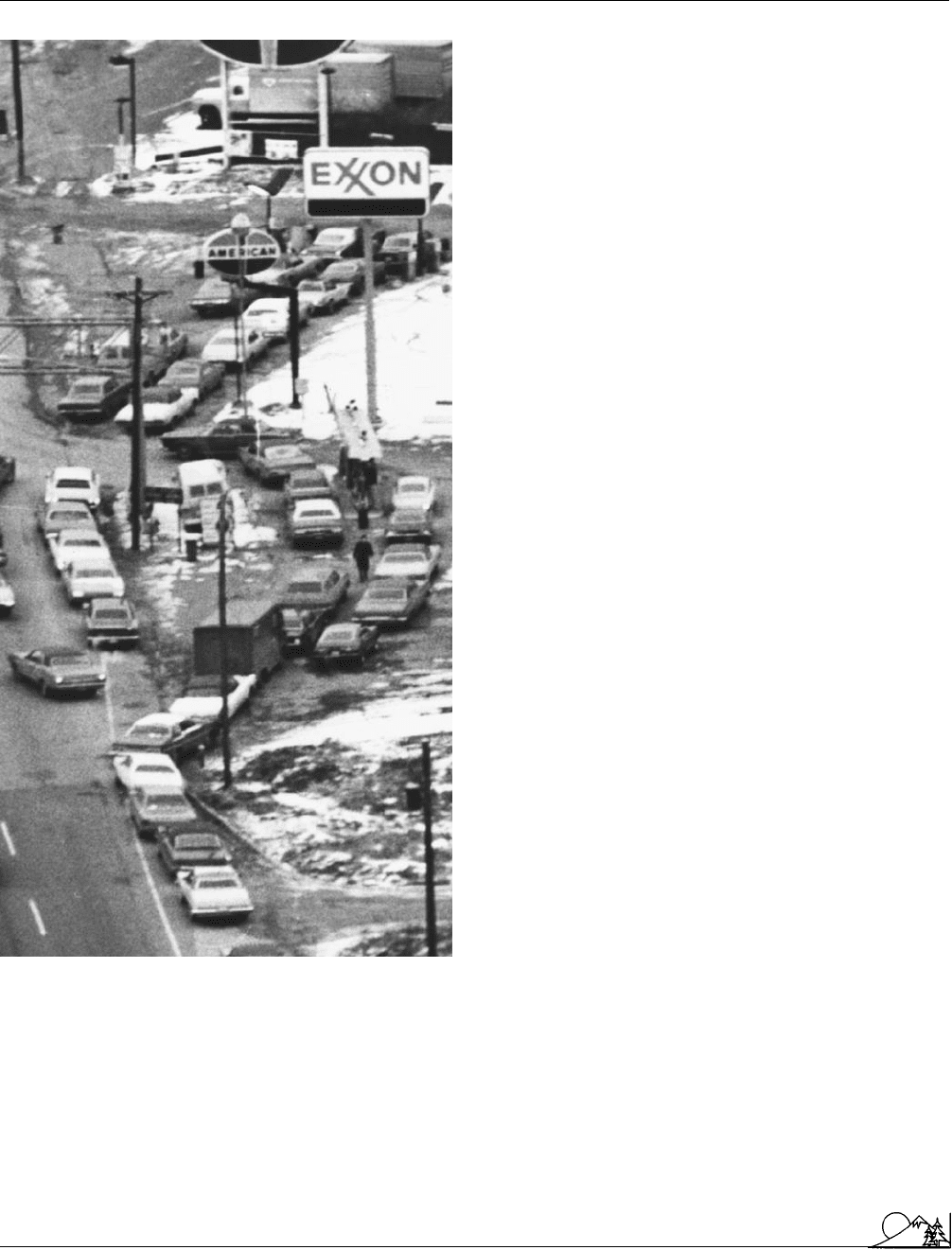
Environmental Encyclopedia 3
Oil embargo
Cars line up for gasoline along Route 4 in Fort
Lee, New Jersey, in 1974. (AP/Wide World Photos.
Reproduced by permission.)
energy, Perez Alfonso saw OPEC as an organization that
could encourage
energy conservation
throughout the
world.
His objectives were certainly achieved in some places as
a result of the 1973 embargo. Americans, along with citizens
1022
of other developed nations, found themselves waiting in long
lines to buy gasoline, turning their thermostats down to 60°,
and learning how to live with less energy in general.
The embargo also had a devastating effect on national
economies. In the United States, inflation climbed to more
than 10 percent a year, an enormous trade deficit developed,
and interest rates climbed to the high teens. Elsewhere, a
global recession began.
By the time the embargo ended in March 1974, oil
prices had climbed to nearly $12 a barrel, an increase of 330
percent. Gasoline prices had also begun to climb, reaching
57% a gallon by 1975, 86¢ a gallon by 1979, and $1.19 a
gallon by 1980.
The embargo caused developed nations to rethink their
dependence on fossil fuels. Research on
alternative energy
sources
such as wind, tides, geothermal, and
solar energy
suddenly attained a new importance. The United States
government responded to the new era of expensive energy
by formulating an entirely new
energy policy
expressed in
such legislation as the Energy Policy and
Conservation
Act
of 1976, the Energy Conservation and Production Act of
1976, the
Energy Reorganization Act
of 1974, and the
National Energy Act of 1978.
Interestingly enough, the OPEC embargo had impacts
that were relatively little known and discussed at the time.
For example, the United States was importing only about 7
percent of its oil from Arab nations in 1973. Yet, almost as
soon as the embargo was announced, prices at the gasoline
pump began to rise. Such a fast response is, at first, difficult
to understand since “old,” cheap oil was still on its way from
the Middle East and was still being processed, shipped and
stored by petroleum companies.
The embargo must also be understood, therefore, as
an opportunity for which oil companies had been looking
to increase their prices and profits. In the years preceding
the embargo, these companies had been feeling increased
pressures from domestic environmental groups to cut back
on drilling in sensitive areas. They were also losing business
to small, independent competitors.
The embargo afforded the companies an opportunity
to turn this situation around and once more increase profit-
ability, which they did. In the one year following the em-
bargo, for example, the seven largest oil companies reported
profits from 40–85%. Two years after the embargo, one of
these companies (Exxon) became the nation’s richest corpo-
ration, with revenues of $45.1 billion.
Neither have the long term effects of the embargo
been what observers in 1973 might have expected. In 1990
the United States imports a larger percentage of its oil from
Arab OPEC members than it did in 1973. And the enthusi-
asm for alternative energy sources of the 1970s has largely

Environmental Encyclopedia 3
Oil spills
diminished. See also Alternative fuels; Energy conservation;
Geothermal energy; Wave power; Wind energy
[David E. Newton]
R
ESOURCES
B
OOKS
Commoner, Barry. The Politics of Energy. New York: Knopf, 1979.
Silber, D., ed. The Arab Oil Embargo: Ten Years Later. Washington, DC:
Americans for Energy Independence, 1984.
Oil pipeline
see
Trans-Alaska pipeline
Oil shale
The term oil shale is technically incorrect in that the rock
to which it refers, marlstone, is neither oil nor shale. Instead,
it is a material that contains an organic substance known as
kerogene. When heated to a temperature of 900°F (480°C)
or more, kerogene decomposes, forming a petroleum-like
liquid and a combustible gas. Huge amounts of high-grade
oil shale exist in the western United States. By some esti-
mates, these reserves could meet the nation’s fuel needs for
about a century. Although the technology for tapping these
reserves already exists, it is still too expensive to compete
with conventional
fossil fuels
or other sources of energy
now in use. See also Alternative fuels
Oil spills
An oil spill is the common expression used to refer to the
release of crude oil or
petroleum
into water or on land.
Crude oil released in this way represents an evironmental
issue of great concern because spills threaten animals, plant
life and other marine resources. Oil can also cause long
term environmental and economic damage to the marine
ecosystem
near a spill. According to a 2002 report from
the
National Academy of Sciences
, approximately 210
million gal (790 million l) of oil spills into the oceans each
year. Sources include the
wells
from which oil is extracted
and the ships used to transport it, as well as natural oil
seepage
from geologic formations below the seafloor, as
for example in
Coal
Oil Point along the California Coast,
where an estimated 2,000–3,000 gal (7,570–11,350 l) of
crude oil is released naturally from the ocean floor every day.
While accidental tanker oil spills receive the most publicity,
they only account for approximately 20% of the crude oil
released into the oceans each year by human activity with the
remainder largely due to routine oil tanker ship maintenance
1023
operations such as
loading
, discharging, and emptying bal-
last tanks.
Oil and spills are often measured in gal (l) or “barrels
of petroleum”; a barrel equals 42 gal (159 l), and a (metric)
tonne equals 7.2 barrels. Tankers sometimes transport more
than 30,000 barrels of oil (200,000 tonnes).
According to a 2002 study performed by the
National
Research Council
, a total of 29 million gal (110 million l)
of petroleum are released into North American ocean waters
each year as a result of human activities or carelessness.
However, only a small fraction of that environmental
pollu-
tion
is due to pipeline ruptures or oil tanker spills. Approxi-
mately 85% of those spills involve land-based runoffs from
cars and trucks, fuel dumping by commercial airplane pilots,
and emissions from small boats and crafts.
Oil and its properties
The word oil usually refers to petroleum, a liquid that
occurs in
nature
and consists of
hydrocarbons
, a group
of organic chemical compounds of
hydrogen
and
carbon
atoms. Petroleum, also known as crude oil, is classified in
categories that range from light, volatile oils (Class A) to
heavy, sticky oils (Class C), depending on physical properties
and charcateristics. Refined oil is crude oil that has been
processed for use as
gasoline
, kerosene, lubricating oil, and
fuel oils of varying weights.
In spills, the majority of oils spread horizontally to
form a smooth, slippery layer on the surface of water. This
surface is called a slick. When oil stays on the ocean surface,
it cuts off the oxygen supply to the marine life below. The
oil also kills birds, animals, and can harm the water supply
and the coastline.
“Fate” is the term used by scientists to describe
what happens to the various oil components after a spill.
Factors that determine fate include the type of oil, the
quantity spilled, water temperature, and
climate
. The fates
of oil are natural processes.
Weathering
is a series of
chemical and physical changes that causes oil to break
down and become heavier than water. Evaporation occurs
when lighter substances in the oil evaporate and leave the
water surface.
About half of a spill may evaporate within several days.
Warm water temperatures help this process. Although oil
evaporates, the process of emulsification may increase the
size of a spill. Emulsions are a mixture of small drops of oil
and water. Wave action mixes together a water-in-oil mix-
ture called “chocolate mousse.” Mousse may remain in the
environment
for months or years, according to the United
States
Environmental Protection Agency
(EPA).
Oxidation reactions may also result from the contact
of oil with water and oxygen. Portions of the slick cling
together in tar balls. Biodegradation occurs when micro-

Environmental Encyclopedia 3
Oil spills
organisms like bacteria feed on oil. How oil affects the
environment depends on the rate at which the oil spreads.
The slick is affected by surface tension, which is the measure
of the attraction between the surface molecules of a liquid.
Oil with a higher surface tension usually remains in one
place. If the surface tension is lower, the oil tends to spread.
Wind and water currents also cause oil to spread. Further-
more, higher temperatures can reduce surface tension so oil
tends to spread more in warmer water.
Light refined products like gasoline and kerosene
spread on the water surface and quickly penetrate porous
soil
. The risk of fire and toxic hazards is high, but these
oils evaporate quickly and leave little residue. Heavier refined
oil products are less of a fire and toxic hazard risk.
Oil spills and their aftermaths
After a spill, oil can spread very quickly unless con-
tained, for example, by a boom or a boat slip. The lighter
the oil, the faster it spreads out. For example, gasoline spreads
faster than heavy fuel oil. Faster currents and winds can also
cause oil to spread faster and temperature can sometimes
make a difference as well because colder oil does not flow
as well and spreads more slowly.
Oil spills have occured all over the world. The Cutter
Information Corporation tracks oil spills involving at least
10,000 gal (34 tonnes). It reports that spills of that magnitude
have occurred in the waters of 112 countries since 1960. Oil
spills are also known to happen more often in some parts
of the world. Major oil spills from tankers have occurred in
the Gulf of Mexico (267 spills); the northeastern United
States (140 spills); the
Mediterranean Sea
(127 spills); the
Persian Gulf (108 spills); the North Sea (75 spills); Japan
(60 spills); the Baltic Sea (52 spills); the United Kingdom
and English Channel (49 spills); Malaysia and Singapore
(39 spills); the west coast of France and north and west
coasts of Spain (33 spills); and Korea (32 spills).
The aftermath of an oil spill always results in environ-
mental damage. During the 1991 Gulf War, oil was spilled
onto Kuwaiti land and into the Arabian Gulf when the Iraqi
Army began destroying tankers, oil terminals, and oil wells.
Approximately 9,000,000 barrels of oil were spilled in the
Arabian Gulf, forming a slick measuring some 600 mi
2
(1,600 km
2
). When the slick moved close to Saudi Arabia,
people pumped water into the area between the beach and
the oil. Some 400 mi (640 km) of the western shores of the
gulf was oiled, with Saudi Arabian shores the most severely
affected, the spill destroying most of its shrimp fields.
In 1989, the
Exxon Valdez
ran aground Bligh Reef
in
Prince William Sound
, Alaska, spilling more than 11
million gal (41 million l) of crude oil. The spill was the largest
in United States history and focused worldwide attention to
the damage caused by oil spills. The first day, thousands of
animals died. During the month after the spill, more than
1024
7,000 sea otters in Prince William Sound died. Other casual-
ties included more than 100 bald eagles, and 36,000 birds
including puffin, auklet and other species. As the oil spread,
people tried to rescue wildlife. They had to calm terrified
animals. Rescuers fed animals and kept them warm. When
the animals were stronger, people started cleaning birds and
mammals.
Three methods were used in the effort to clean up the
spill, namely burning, mechanical cleanup and the use of
chemical dispersants. Burning was conducted during the
early stages by placing a fire-resistant boom on tow lines,
with two ends of the boom each attached to a different ship.
The two ships with the boom between them sailed very
slowly throughout the slick until the boom was full of oil.
They then towed the boom away from the slick and the oil
was set on fire. The procedure did not endanger the main
slick nor the Exxon Valdez, because a safe distance separated
them. Mechanical cleanup was also carried out using booms
and skimmers with people cleaning birds and mammals.
Chemical dispersants were also used in the cleanup effort
but were not very effective because there was not enough
wave action to mix the dispersant with the oil in the water.
The aftermath of the Exxon Valdez spill included the
adoption of the federal Oil Pollution Act of 1990. The law
created a spill clean-up fund, set penalties for oil spillers,
and directed the federal government to respond quickly to
oil spills. In 1993, federal law required a double hull for all
tankers carrying oil to the United States.
The United States produces an average of 125 billion
gal (473 billion l) of crude oil each year. The country imports
an additional 114 billion gal (430 billion l) and 29 million
gal (110 million l) of oil enter coastal waters off the United
States each year. Nearly 85% of that oil comes from polluted
rivers, small boats, vehicles, and street run-off. As a result,
the National Academy of Sciences has called on the federal
government to work with state environmental agencies to
address these issues.
In the United States, various techniques are used to
respond to oil spills. Containment and recovery are usually
the primary goals of the response team. Equipment includes
booms and skimmers that are used to collect the oil and
store it. Floating booms are mechanical barriers that extend
above and below the surface of the water to stop the spread
of oil. They can be used to surround a slick completely and
reduce its spread, to protect harbor entrances or biologically
sensitive areas, and to divert oil to an area where it can be
recovered. Dispersants are
chemicals
used to break up oil
and keep it from reaching the land. Furthermore, the spill
response team works to keep birds and animals away from
the oil spill area. Their equipment includes propane scare
cans, floating dummies, and helium balloons.
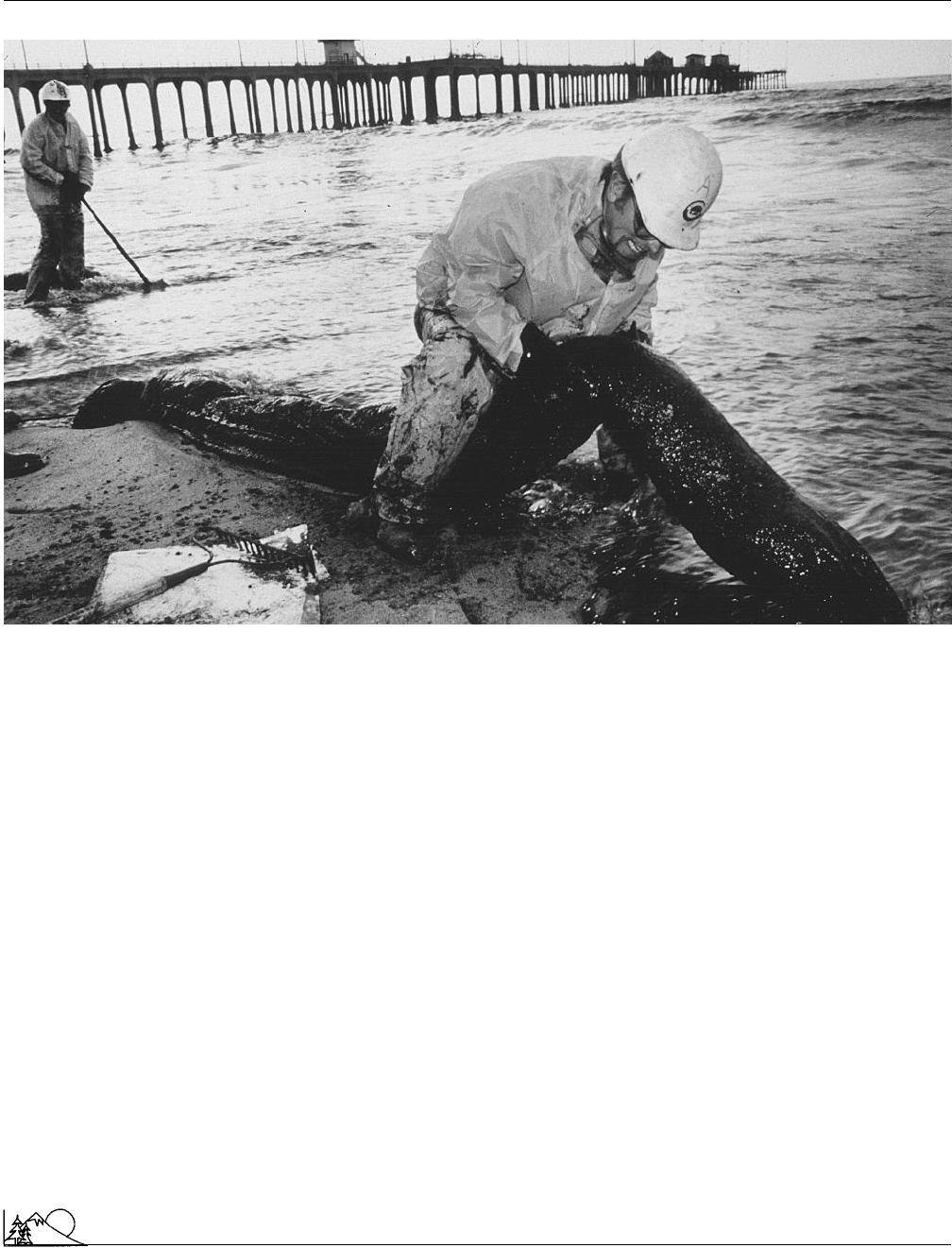
Environmental Encyclopedia 3
Oil spills
Workers clean up an oil-fouled California beach. (Corbis-Bettmann. Reproduced by permission.)
Oil spills on a global level
The EPA, the
National Oceanic and Atmospheric
Administration
, and the American Petroleum Institute are
among the sponsors of the International Oil Spill Confer-
ence. Since 1969, the conference has been scheduled every
two years. Goals include delineating the overall oil spill
problem and exploring ways to prevent and respond to spills.
A 2003 conference was planned in Vancouver, British Co-
lumbia.
Oil spills are a global problem. In 1999, the tanker
Erika caused the greatest oil spill in European history. The
tanker broke and spilled 3 million gal (11 million l) of oil
off the coast of Brittany, France. The following year, a
pipeline ruptured and spilled 343,200 gal (1.3 million l) of
oil into Guanabara Bay in Brazil. And in 2000, the tanker
Westchester ran aground south of New Orleans, spilling
567,000 gal (2.1 million l) of oil into the Mississippi River.
That was the largest spill in the United States since the
Exxon Valdez.
Environmental organizations concerned with oil spills
include the Sea Shepherd Conservation. Founder Paul Wat-
son’s goal in 2002 was to create a coalition of oil producers
1025
and conservationists. The coalition would develop airborne
teams that would respond to oil spills within 12 hours. Team
equipment would include items for cleaning wildlife and
pumps for oil.
[Liz Swain]
R
ESOURCES
B
OOKS
Burger, Joanna. Oil Spills. New Brunswick, NJ: Rutgers University
Press, 1997.
Fingas, Mervin F., and Jennifer Charles. The Basics of Oil Spill Cleanup,
Second Edition. Boca Raton: CRC Press, 2000.
Garcia-Martinez, R., and C. A. Brebbia, eds. Oil and Hydrocarbon Spills,
Modelling, Analysis and Control. Southampton, UK: Computational Me-
chanics (WIT Press), 1998.
Hayes, Miles. Black Tides. Austin: University of Texas Press, 1999.
Keeble, John, and Natalie Fobes. Out of the Channel: The Exxon Valdez Oil
Spill in Prince William Sound. Seattle: University of Washington Press, 1999.
O
RGANIZATIONS
EPA - Oil Spill Program, UNIDO New York Office, Toll Free: 800-424-
9346, Email: oilinfo@epa.gov, <http://www.epa.gov/oilspill/>
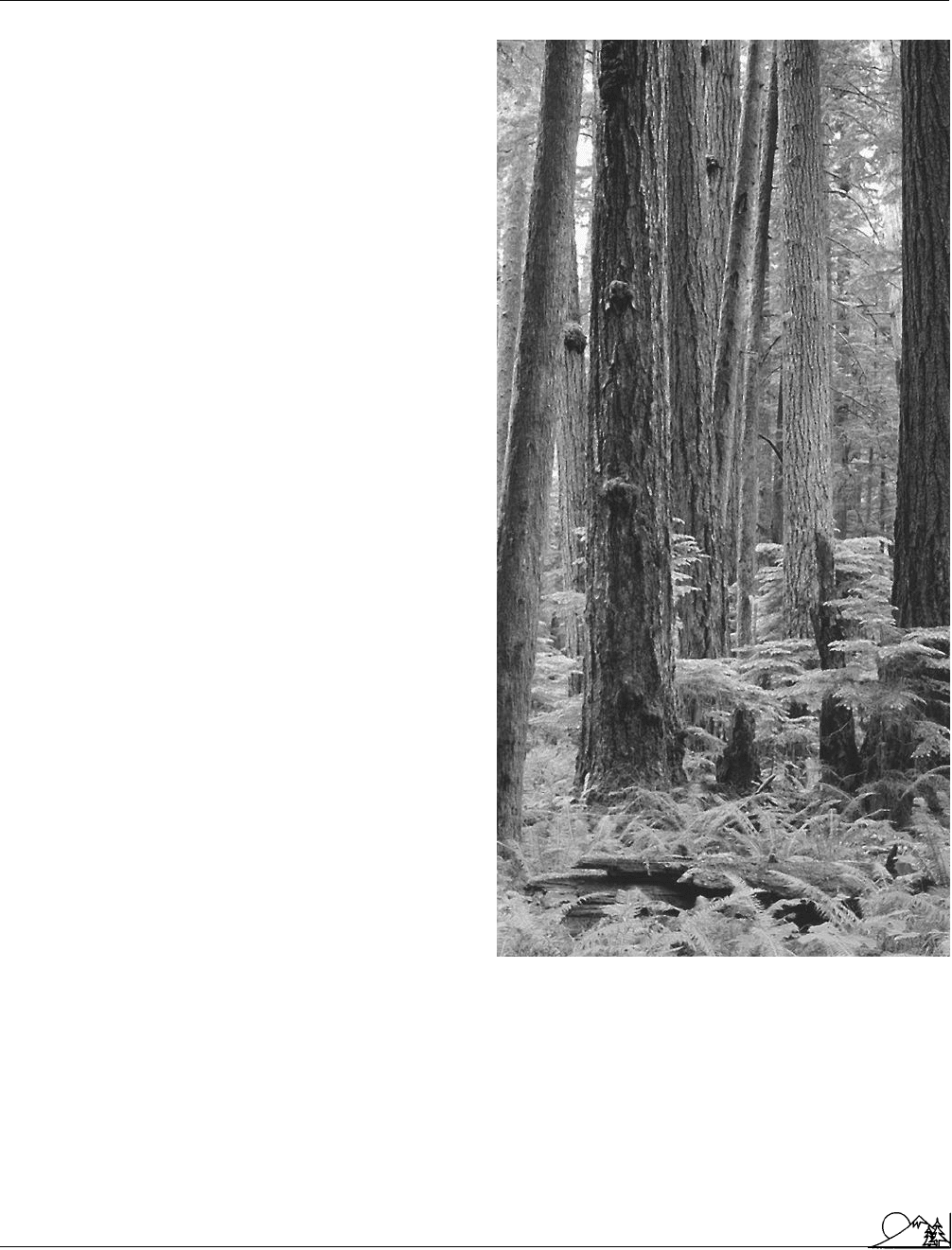
Environmental Encyclopedia 3
Old-growth forest
International Tanker Owners Pollution Federation Limited, Staple Hall,
Stonehouse Court, 87-90 Houndsditch, London, U.K. EC3A 7AX
+44(0)20-7621-1255, Toll Free: 800-424-9346, Email: central@itopf.com,
<http://www.itopf.com/index2.html>
National Oceanic and Atmospheric Administration., 14th Street and
Constitution Avenue NW, Room 6013, Washington, D.C. USA 20230
(202) 482-6090, Fax: (202) 482-3154, Email: answers@noaaa.gov, <http://
www.noaa.gov>
Oil Spill Response Ltd (ORSL), 1 Great Cumberland Place, London,
U.K. W1H 7AL +44 (0)20-7724-0102, Toll Free: 800-424-9346, Email:
orsl@orsl.co.uk, <http://www.oilspillresponse.com/>
Sea Shepherd International., 22774 Pacific Coast Highway, Malibu, CA
USA 90165 (310) 456-1141, Fax: (310) 456-2488, Email:
seashepherd@seashepherd.org, <http://www.seashepherd.org>
The National Academies, 2101 Constitution Avenue, NW, Washington,
DC USA 20418 (202) 334-2000, , <http://www4.nationalacademies.org>
Oil-recycle toilet
see
Toilets
Old-growth forest
The trees stand tall and thick of girth. The air about them
is cool and moist. The
soil
is rich and matted by a thick
organic blanket. People marvel at the forest, imbibing its
grandeur, coveting its timber. In another area, across the
mountains, perhaps, the trees stand stooped and scraggly.
The air about them is parched. The soil is coarse, barren,
and hardened to the elements. People pass by the forest,
ignoring its dignity, rejecting its worth.
These images reflect extremes in old-growth forests.
The first is the compelling one: it exemplifies the common
perception of a
ecosystem
at the center of a bitter environ-
mental controversy. The second depicts an equally valid old-
growth forest, but it is one whose fate few people care to
debate.
The controversy over old-growth forests is the result of
competition for what has become a scarce natural resource—
large, old trees that can be either harvested to produce high
value lumber products or preserved as notable relics as a
forest proceeds through its stages of ecological
succession
.
This competition is a classic environmental struggle, im-
pelled by radically different perceptions of value and conflict-
ing goals of consumptive and nonconsumptive use.
What is an old-growth forest? Before the modern
debates, the definition seemed simple. Old-growth was a
mature virgin forest; it consisted of giant old trees, many
past their prime, which towered over a shady, multilayered
understory and a thick, fermenting forest floor. In contrast
to second-growth timber, the stand never had been har-
vested. It was something that existed in the West, having
long since been cut in the East.
1026
Old-growth Douglas fir forest, Pacific North-
west. (Photograph by Tom and Pat Lesson. National
Audubon Society Collection/Photo Researchers, Inc. Re-
produced by permission.)
In the mid to late 1980s several professional and gov-
ernmental organizations, including the
Society of American
Foresters
, the U.S.
Forest Service
, and California’s State
Board of Forestry, began efforts to define formally “old-
growth forest” and the related term “ancient forest” for eco-
